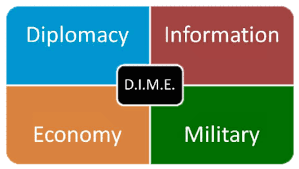Jessica Budlong, MAJ Amos Fox
Younger generations are particularly interested in the future of Competition and Conflict, and seek to be heard and have an impact in the national security arena. They recognize that although it is difficult to predict the future security landscape, our Nation’s agility in responding to rapidly evolving threats will be critical to mission success. As such, they conceptualize strategy and competition as a constant process that must be continuously adjusted and maintained. These generations conceptualize the future of national security in novel ways and can help the Army frame its vision for the future.
1. Although new to us, most trends and threats in national security will have historical precedent. Conceptualizing national security in this way embodies the idea of “combinatorial creativity,” in which ideas and techniques from one industry are applied to a new one. Thus, integrating security efforts across Government agencies and with the private sector can promote the flow of ideas, and allow for more creative solutions to emerging threats.
The panelists noted that China’s Military-Civil Fusion facilitates this integrated “triple helix” approach. They argued that the United States should consider new ways to expedite the flow of ideas beyond the creation of task forces, which are often temporary in nature. One way in which this could be done would be by increasing investment in Federally Funded Research and Development Centers (FFRDCs), which enlist creative thinkers to solve problems and promote new ideas.
2. The line between war and peace will continue to blur, challenging our cognitive security. Although competition with peers like China and Russia will escalate, so too will opportunities to collaborate (e.g., on climate change). As the grey zone widens, it will be difficult to describe competitors as strictly allies or adversaries, increasing complexity in the international sphere. Importantly, however, this feature of competition is not new, as panelists noted that the United States and the Soviet Union cooperated in space, even at the height of the Cold War.

3. The information sphere is democratizing, allowing the information pillar of DIME to stretch across all domains. Increased accessibility and proliferation of disinformation will challenge trust across entire generations. The ethical implications of the United States engaging in offensive information operations are still debated, and very few DoD offices have the authority to engage in such practices. Regardless of whether it chooses to employ this tactic, the United States must determine how to maintain credibility both domestically and abroad as disinformation becomes more engaging and accessible.
To thrive in this constantly evolving, competitive security space, the panelists recommend the United States and the Army develop a variety of critical competencies, from defined grand strategy practices to a thriving team mentality. Adjustments in U.S. military budgets will need to be made to meet these objectives. While cutting excess and overhead will help, the panelists also acknowledged that Senior Leaders need to better collaborate with Congress in order to define DoD goals and ensure that the U.S. budget aligns correctly with its stated priorities. Along these lines, the panelists proposed:
1. Creating diverse and innovative teams with a culture of experimentation and learning will be critical to Army success in competition and conflict. Supporting Soldiers to take risks, learn, and share their experiences will create a culture of innovation. These teams will require leaders who operate based on a “we” mentality, connect their members with resources and personnel to support their efforts, and are willing to change course when a technique no longer works. The panelists noted that leadership will be the defining element of success in great power competition, and the best leaders will be collected under pressure and willing to adapt.
To create teams with these characteristics, the panelists argued that the United States should increase spending on Professional Military Education (PME). The panelists asserted that problems and solutions start with people. By increasing training and retraining of our forces, we can maintain the U.S. comparative advantage in creative and resilient Services.
The United States can leverage significant demographic and cultural diversity, a major strength compared to our peer competitors. The U.S. military and security sphere should prioritize recruitment and retention of diverse perspectives. The panelists even suggested revisiting the accessibility of security clearances in order to fully leverage these populations.
2. Explicitly define each desired end-state and describe acceptable conditions and responses to them. Establishing clearly defined goals and accounting for sub optimization will allow the United States to build in off-ramps on both sides and lead to the creation of a consistent and acceptable grand strategy. Defining objectives will also allow the United States to distinguish between problems to be solved vs problems managed, creating achievable expectations.
3. The United States should shift from prioritizing power projection capabilities to prioritizing denial capabilities. Developments in AI and cyber are largely offensive-dominant and can in many ways undermine stability of the international system. However, “a willingness to go somewhere different” could enable the United States to maintain strength in the international arena while simultaneously creating a more stable international order.
The panelists noted that creating the type of change they hope to see will take time. While younger generations are excited to make an impact, they will still need to be incentivized to become involved in security. In many cases, this effort will involve incentivizing older generations to be open to the ideas and propositions of the incoming generations. Developments will be part of “the long game” and will require a holistic approach: synthesis between generations and between the public and private sectors.
The panelists argued that advancement can be achieved by optimizing and augmenting processes that already exist, and fully committing to applying what we have already learned to new areas of the government. This effort may take the form of integrating new technology or reimagining an existing policy. By continuously experimenting, acknowledging what doesn’t work, and institutionalizing what does, the United States can ensure it maintains its position as a global leader.
No comments:
Post a Comment